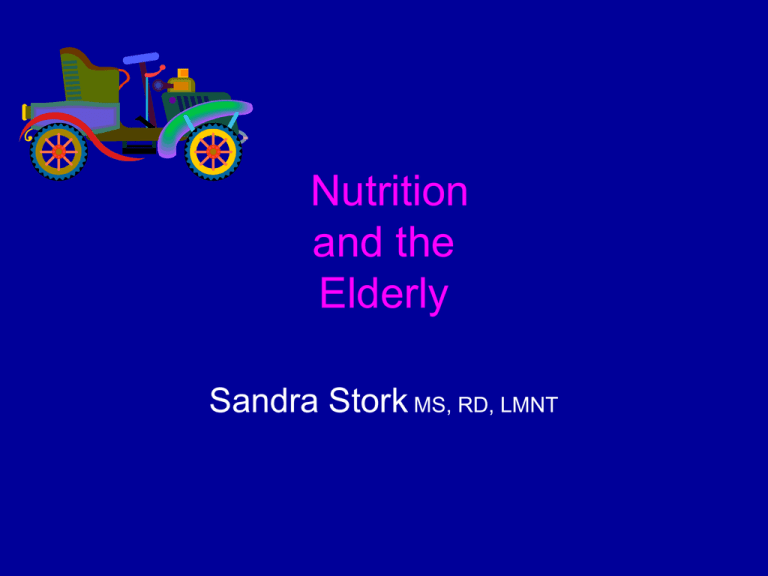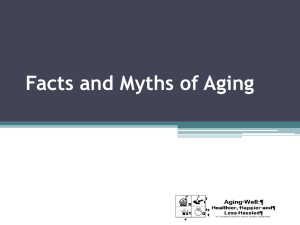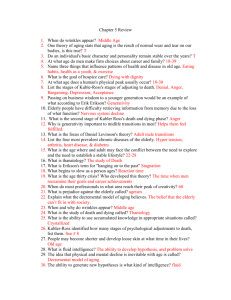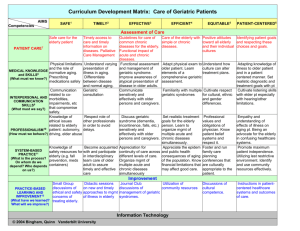Nutrition and the Elderly Sandra Stork
advertisement

Nutrition and the Elderly Sandra Stork MS, RD, LMNT Nutrition and the Elderly • Why study nutrition and the elderly? Definition of Terms • OLD – usual categorization – Young Old – 65 -74 – Middle Old – 75 – 84 – Old Old - 85 and older • HETEROGENEOUS POPULATION IQ Pre-Test • IQ = Inquiry Quotient • Test your knowledge and stimulate your interest and inquiry. Topics • Changes of Aging Related to Nutrition • Geriatric Problems • What’s “new” in the “old”? Objectives After presentation, discussion, and completing practice problems, you will be able to: • Describe the “Guiding Principles” of Nutritional status and care in the elderly. • Identify nutrients pertinent to elderly. • Review the physiologic changes of aging which impact nutritional status and care. Objectives • Identify the association between selected Geriatric Problems and nutrition: – Sarcopenia – Dehydration – Dementia – Constipation -Weight Loss -Swallowing -Pressure Ulcers -Depression • Develop strategies for the treatment of these problems. • Reduced Nutrient Reserves • Reduced Response to Stress Nutritional Care in Geriatrics Geriatric Problems • What geriatric problems impact nutritional status? Sensory Changes with Aging Sensory Changes with Aging • Decreased sense of smell due to decreased olfactory cells • Decreased vision • Hearing loss • Tactile loss Sensory Changes with Aging • Decreased number of taste buds – i Loss of sweet and salty – Less loss of bitter and sour – ? Umami – ? Piquant – Dry mouth prevents adequate tasting Psycho-Social Changes of Aging Psycho-Social Changes of Aging • Economic – Less income; less money for food • Social – Lack of Socialization – Loss of mobility; can’t drive – Loss of friends and loved ones • Psychological – Loss self-worth; value – Depression; BIG problem (Bayer quote) Depression …………… The attitude that: “Of course he/she is depressed, I’d be depressed too if I were that old and had all those problems…..” puts elderly at risk of not receiving clinical attention for a very treatable disorder. Just because it is “understandable”, does not mean that depression is inconsequential or normal as people age. Barb Bayer, RN, MSN, CS Depression …………… is the most common psychiatric condition affecting the elderly, but it is often unrecognized and untreated. The myth that depression is just a natural part of aging is widespread in our youth-oriented society. It is also a belief held by many elderly themselves, their families, and unfortunately, many health care professionals. Geriatric Problems • • • • • • • • Weight Loss Sarcopenia Dehydration Swallowing Dementia Pressure Ulcers Constipation Depression Optimal Weight • Weight is Primary Parameter • Standard Tables vs. TRENDS – Identify unintentional weight change – Attention to trends • Optimal Weight – Maximize function and quality of life – Minimize disease risk Usual Weight Trends Epidemiology • Gradual Weight Gain – Middle Age • Peak Weight at 75 years • Gradual Weight Loss after age 75 Unintentional Weight Loss • Weight loss >5% in 30 days • >7.5% in 90 days (three months) • >10% in 180 days (6 months) • Example: – 5% 7-8# in 154# = 146# – 10% 15# in 154# = 139# Long Term Care Guidelines American Healthcare Association Identifying Weight Change • • • • Weight History Change in Clothing Fit Decrease in Functional Ability Dietary Intake Records These methods are readily accessible and cost effective Impact of Weight Loss • Most indicative screening parameter • Greater clinical significance • Less reserve capacity • Difficulty regaining weight • Loss of functional ability Weight and Mortality Potter, et al, 1988 Corrada, et al, 2006 Strategies: Calories Rule of Thumb • Energy needs are dependent on activity and physiologic stress levels • 25-30 kcal/kg • Basal Energy Equation X factor of 1-1.5 – Harris Benedict Equation – Mifflin St-Jeor Equation (Currently recommended) Strategies: Calories • Avoid unnecessary dietary restrictions • Encourage use of nutrient dense foods • Use more frequent meals plus supplements or snacks Strategies: Calories Practical Suggestions • Use foods that are well liked frequently • Provide double portions of favorite foods • Add calories by using sauces, gravies, toppings, and fats • Emphasize calorie containing liquids to meet fluid needs Obesity • h numbers reaching older age as obese (30.5% in NHANES) h physical and cognitive disability • h risk of dependency and • institutionalization • h health care costs, poor health outcomes, mortality Houston, et al, JADA, Nov. 2009 Obesity Treatment • Goal: To better manage health and maintain independence longer • Minimize loss of muscle mass – Adequate protein – Exercise (aerobic and resistance) • Minimize loss of bone density – Adequate calcium, Vitamin D – Exercise (weight bearing) • Adequate nutrient intake Sarcopenia • Definition: Loss of muscle mass in aging. • Results: Lower basal metabolic rate – Weakness -Decreased Functional Status – Reduced Activity Level – Decreased Bone Density • Practical Application – Progressive Resistance Exercises – Adequate Protein Protein •Higher protein intake required to maintain nitrogen balance •Contributors: –Lower energy intake –Impaired insulin action –Decreased efficiency of protein utilization J.Nutr.Healthy Aging, 2006 Protein •1.0-1.25 gm/kg/day •At least one high protein food at each of three meals •Physical activity to maintain muscle mass -Exercise against resistance Protien Practical Suggestions •Add nonfat dried milk solids •Add cheese, peanut butter, eggs and nuts (if dentition permits) •Use commercial protein powders or supplements Geriatric Problems • • • • • • • • Weight Loss Sarcopenia Dehydration Swallowing Dementia Pressure Ulcers Constipation Depression Dehydration: Causes • • • • Decreased thirst sensation with aging More dependent on others to obtain fluid Decreased ability to concentrate urine Increased incidence of incontinence with self-imposed fluid restriction • Increased use of medications contributing to dehydration • Increased losses: vomiting, diarrhea, fever Dehydration: Symptoms • • • • • • • Decreased Skin Turgor Dry Mouth and Mucosal Membranes Decreased Urine Volume Darker Urine Constipation Acute Weight Loss CONFUSION Dehydration Practical Application • • • • • • Treat Cause Set Fluid Goal Goal: 30 cc/kg or 1 cc/Kcal Replace Additional Fluid Losses Drink Fluid At and Between Meals Use Foods Which Have Fluid Value Fluids • Which fluid is the best fluid? Fluid:Nutrient Comparison Fluid Free Water (cc) Calories/Protein Water 240 cc (100%) 0/0 Juice (Apple) 210 cc (88%) 111/0 Whole Milk 214 cc (89%) 150/8 Instant Breakfast Fruit Beverage Supplement 217 cc (80%) 250/13 191 cc (79%) 300/10 Fluids • What about caffeine for the elderly person? • Have a balanced approach. • Caffeine naivety. Journal American College of Nutrition, 2003 Swallowing Problems S Swallow is difficult or hard to initiate W Wet sounding voice A Aspiration pneumonia in history L Loss of fluid through the nose L Leakage of food or liquid out of mouth when eating O Overt coughing or choking with oral intake W Weight loss with inadequate nutritional intake I Involve Speech Pathologist and others N Nutrient Density G Go for Least Restrictive Swallowing Practical Application • • • • Be Alert to Symptoms Consult Speech Pathologist Involve Dietitian/Nutrition Appropriate Fluid and Nutrient Density Geriatric Problems • • • • • • • • Weight Loss Sarcopenia Dehydration Swallowing Dementia Pressure Ulcers Constipation Depresssion Dementia • Weight Loss Primary Nutritional Problem • Stage of Disease Important • Eating Behaviors Eating Behaviors: Overview • • • • Eating is NOT just food Barometer of well being Social interaction Symbolic of life Eating Behaviors: Examples • • • • • • Distracted at meal times Eat non-finger foods with hands Consume non-food items Eat pieces that are too big Incorrect use of utensils Resistive to eating Principles of Management • Assess problems • Utilize creative strategies to address individual problems • Think OUT OF THE BOX • Alternate strategies • Continue reassessment process • Multidisciplinary approach Eating Behaviors: Questions? • • • • • What is being said by behaviors? Are behaviors harmful? What precipitated the behaviors? Is there an unmet need? What are potential causes? Eating Behaviors: Strategies • • • • • • • Consistent eating patterns Quiet environment Sit when feeding Only food items on table Cut and season food prior to serving Provide (double) favorite foods Provide verbal and tactile cueing Geriatric Problems • • • • • • • • Weight Loss Sarcopenia Dehydration Swallowing Dementia Pressure Ulcers Constipation Depresssion Pressure Ulcers • Screening Tool: (Example – Braden Scale) – – – – – Sensory Perception Moisture Activity Mobility Friction and Sheer – Nutrition • Cooperation and Collaboration Needed – Nutrition is only one component Pressure Ulcers: Nutrition • Protein: 1.25 to 2.0 gm/kg • Vitamin/Mineral Supplementation – Useful with poor intake or depletion – Vitamin C: 1 to 2 gm/day – Zinc Sulfate: 220 mg/day Geriatric Problems • • • • • • • • Weight Loss Sarcopenia Dehydration Swallowing Dementia Pressure Ulcers Constipation Depression Robertson’s Rule of 2’s Food Item Amount Dietary Fiber 100% Bran cereal 1/2 cup or or Miller’s Bran 2 Tablespoons 10-14 grams Whole Wheat Bread 2 slices 4 grams Fresh Fruit 2 pieces 4 grams Vegetables 2 servings 4 grams Total 22-26 grams Fiber Supplementation •Alleviation of constipation •Crude fiber content increased by 6-8 gm •60% residents •JAGS, 1980, 28:410 •Increased stool frequency •Fiber increased 3-12 gm •Decreased laxative use •JADA, 2003,103:1199 Geriatric Problems Principle: Avoid unnecessary dietary restrictions. Nutrients of Concern in the Elderly • Calories – Nutrient Density • • • • Protein Calcium Vitamin D Supplements? • Don’t forget – Fiber – Fluids Osteoporosis •High incidence of osteoporosis –33% of women 60-70 years old –66% of women > 80 years old •Less efficient absorption of calcium and Vitamin D •Reduced exposure to sun = reduced conversion of inactive D to active D •Supplementation essential –1200-1500 mg/day Vitamin D • Most tissues and cells have Vitamin D receptors -Skeletal muscles, brain, prostate, breast, colon, immune cells • Active D controls more than 200 genes which are responsible for: -Cell proliferation, differentiation, apoptosis, angiogenesis • Potent immunomodulator Serum 25-hydroxyvitamin D • <20 ng/mL Deficiency • 20-29 ng/mL Insufficiency • 30-80 ng/mL Optimal Level • >80 ng/mL Possible Toxicity Prevelance of Deficiency • 40 to 100% of U.S. & European elderly men & women living in the community are deficient in D • >50% of postmenopausal women taking medication for osteoporosis have suboptimal levels of D (<30 ng/mL) Prevention & Maintenance • 800-1000 IU Vitamin D3 per day • 50,000 IU Vitamin D2 every two weeks or every month • Daily sun exposure 5 to 30 minutes 10 am to 3 pm Treatment of Deficiency • 50,000 IU of Vitamin D2 weekly for 8 weeks • Repeat for another 8 weeks if 25-hydroxyvitamin D <30ng/mL Oral Supplementation • Cochrane Systematic Review • Effectiveness of nutritional supplements in elderly at risk for malnutrition • Review of 62 trials – 10,187 randomized patients – Maximum duration of intervention: 18 months •Milne, AC, et al, Protein and energy supplementation in elderly people at risk from malnutrition. Cochrane Database of Systematic Reviews, 2009, Issue 2. Oral Supplementation • Significantly improved mortality in undernourished • Small, consistent weight gain in 42 trials • Reduced risk of complications in 24 trials • No evidence of functional improvement • No reduction in Length of Stay Oral Supplementation Practical Suggestions • Product Acceptance • Taste Fatigue • Supplementation not Meal Replacement Oral Supplements • Carbohydrate Powder – Polycose (23 kcal/Tblsp) • Protein Powder – Beneprotein (6 gm protein/packet) • Carbohydrate & Protein – Benecalorie (330 kcal & 7 gm protein/1.5 oz) – ProMod (100 kcal & 10 gm protein/1 oz) Oral Supplements 100 kcal/1 oz 6 gm/pkt 10 gm protein 330 kcal/1.5 oz 7 gm protein 23 kcal/Tbl Vitamin/Mineral Supplements • A daily multivitamin mineral supplement is recommended • Geriatric Vitamins + Vitamin C,D,E + Vitamin B6 + Vitamin B12 - Iron Cholesterol in the Elderly • Serum cholesterol used to identify malnutrition in the elderly • Serum cholesterol below 150 indicative of malnutrition “NEW” Information • What’s “new” in the “old”? Appetite Stimulation Sensory Changes with Aging • Decreased sense of smell due to decreased olfactory cells • Decreased number of taste buds • Decreased vision Appetite Stimulation Benefits to Increasing Appetite • Reverse anorexic cycle – Failure to eat – Ketone build up – Loss of appetite • Promote Nitrogen Balance • Further stimulate appetite • Consider tube feeding; night feeding Appetite Stimulation: Research • Megestrol Acetate (MA) • N= 51 men; Average Age 76 • Weight loss > 5% in 3 months or > 20% below “ideal” weight • 800 mg MA/day • 12 weeks on MA; 13 weeks off MA • Weighed monthly • Control – no MA Research Results • 12 weeks on MA – No significant wt. gain • 13 weeks after MA – Wt. gain (> 4#) was significantly increased in MA patients • 38% of MA pts did not gain wt; wasted, advanced dementia; more medical conditions; greater than 10 medications • All who gained wt, gained lean body mass • ?? Functional Benefit ?? Research Conclusions • In geriatric patients, MA may promote weight gain, but anticipate a delayed response • Initiate treatment early • 800 mg was tolerated by elderly patients “Vittles, Vitamins & the Vintage Old”: Macular Degeneration • Studies in the elderly suggest that the use of large doses of certain vitamins and minerals are beneficial in the prevention of macular degeneration • Some evidence exists that improvement in existing damage may be seen “Vittles, Vitamins & the Vintage Old”: Macular Degeneration Vitamin/ Mineral A Amount % DV 14,320 IU 286 C 235 mg 371 E 200 IU 667 Zinc 348 mg 232 Copper 0.8 mg 40 WARNING Vitamin A Intake • Vitamin A directs the process of borrowing and redepositing calcium in the bone • Too much preformed Vitamin A (retinol) can promote fractures. • Use Vitamin A in form of beta-carotene, a precurser form which does not increase fracture Topics • Changes of Aging Related to Nutrition • Geriatric Problems • What’s “new” in the “old”? Post - Test • What is one “NEW” thing that you have learned that you did not know before?





